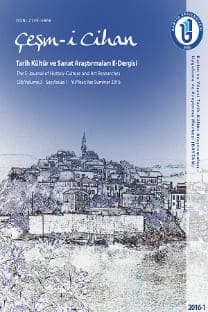ANTİK DÖNEMDE BARTIN/PARTHENIA
Parthenios (Bartın Çayı) nehri antik Dönemde Paphlagonia ile Bithynia Bölgeleri arasında doğal bir sınır oluşturmaktadır ve M.Ö.8.yüzyıldan itibaren antik kaynaklarda isminden sıklıkla bahsedilmektedir. Hellenisik ve Roma Dönemlerinde bölgenin yönetim merkezi olan Amastris kentinin sikkeleri üzerinde Parthenios nehrini simgeleyen betimlemeler, nehrin özellikle iç bölgelerden Karadeniz’e taşımacılık konusunda önem kazandığını vurgulamaktadır. Roma Dönemi’ne ait mil taşları üzerinde Parthenius olarak ismi geçen ve Erken Bizans döneminde Parthenia Kome olarak belirtilen yerleşimin Parthenios nehri ile ilişkili olduğu anlaşılır. Bu çalışmada öncelikle Parthenios nehrinin isim kaynağı, Parthenius ya da Parthenia Kome yerleşiminin varlığı kanıtlanmaya çalışılmaktadır.
Anahtar Kelimeler:
Paphlagonia, Parthenios, PartheniaKome, Bartın
BARTIN/PARTHENIA IN THE ANCIENT TİME
Parthenios River (Bartin Cayi) constituted a natural border between Paphlagonia and Bithynia regions in ancient times. His name is mentioned frequently in ancient sources from 8th Century B.C. Parthenios, as a rivergod, depicted on coins of Amastris which is the formal center of the region. These descriptions emphasize that Parthenios was important for transport of commercial productions from inside of regionto Black Sea. Parthenius that seen on mile Stones from Roman Period and Parthenia Kome that mentioned in Early Byzantine Period, Sign the same city in connection with Parthenios River. This study aim firstly to find the source of Parthenios name and the secondly to prove the presence of Partheniusor Parthenia Kome settlement.
Keywords:
Paphlagonia, Parthenios, PartheniaKome, Bartin,
___
- Ainsworth, W. , “Notes on a JourneyfromConstantinople, byHeraclea, to Angora, in theAutumn of 1838”, Journal of theRoyal Geographical Society of London, Vol. 9 (1839), s. 216‐276.
- Altınoluk, Z.S.,Sikkelerin ışığında Küçük Asya’da Irmak Tanrıları, İstanbul Üniversitesi, Sosyal Bilimler Enstitüsü , İstanbul, 2005 (Yayınlanmamış Doktora Tezi)
- Apollonios Rhodios, TheArgonautika: Expanded Edition, (Trans.P.Green), London, 2007.
- Arrowsmith, A.,A Compendium of Ancient and Modern Geography, London, 1839.
- Aşcıoğlu, E. , Bartın, Ankara,1984.
- Blakely, S.,Myth, Ritualand Metallurgy in Ancient Greece and Recent Africa, Cambridge, 2006.
- Belke, K.,TabulaImperii Byzantini 9. Paphlagonienond Honorias, Wien, 1996. Bell, R.E.,Women of Classical Mythology, Oxford, 1993.
- Clavijo, R.G.de.,Narrative of embassy of Ruy Gonzalez de Clavijo to the Court of Timour at Samarcand, AD 1403‐6, Clements R. Markham F.R.G.S. printed for theHakluyt Society. Londra, 1859.
- Daly, K.N.,Greekand Roman Mythology, New York, 2009.
- Dörner, F.K., “Parthenopolis”, in: PaulusRealencyclopädie der classischenAltertumswissenschaft (RE), Band XVIII.2, Stuttgart, 1942, s.1936.
- Drakoulis, D. P., “Regionaltransformationsandthesettlement network of the coastal Ponticprovinces in theEarly Byzantine period”, in: The Black Sea, Paphlagonia, Pontus and Phrygia in Antiquity Aspects of archaeology and ancient history (ed.Gocha R. Tsetskhladze), BAR International Series 2432, 2012, s.79‐96.
- Erciyas, D. B.,Studies in TheArchaeology of Hellenistic Pontus: TheSettlements, Monuments, andCoinage of Mıthradates VI and His Predecessors, (Electronic ThesisorDissertation.) University of Cincinnati, 2001. https://etd.ohiolink.edu/
- Evliya Çelebi, Evliya Çelebi Seyahatnamesi: Bursa‐Bolu‐Trabzon‐Erzurum‐Azerbeycan‐Kafkasya‐ Kırım‐Girit,2. Kitap‐1.Cilt, (haz.Y.Dağlı‐S.A.Kahraman), İstanbul, 2011.
- Eyice, S.,Küçük Amasra Tarihi ve Eski Eserleri Kılavuzu, TTK Yayınları, 1965. Freeman, C.,Mısır Yunan ve Roma Antik Akdeniz Uygarlıkları, (Çev. Suat Kemal Angı) , Ankara, 2010.
- French, D.,Roman Roads and Milestones of Asia Minor, Vol.3, Milestones Fasc.3.4 Pontus et Bithynia, Electronic Monograph 4, British Institute Ankara, 2013.
- Guettel‐Cole, S., “Domesticating Artemis”, in TheSacred and Feminine in Ancient Greece (ed.S.Blundell‐M.Williamson),London, 2005, s.24‐41.
- Herodotos, Herodot Tarihi, (Çev.Müntekim Ökmen), İstanbul, 1991.
- Hesiodos, “Theogonia”, Hesiodos Eseri ve Kaynakları, (Çev.S.Eyuboğlu‐A.Erhat), TTK, Ankara, 1991, s.103‐140.
- Hirschfeld, G.,Inschriftenaus dem NordenKleinasiensbesondersausBithynienundPaphlagonien, Sb.Ak.Wiss.Berlin, phil.‐hist. Kl.1888, II, 863‐892.
- Homeros, İlyada,(Çev. A.Erhat‐A.Kadir), İstanbul, 1984.
- Işık, A.,Antik Kaynaklarda Karadeniz Bölgesi, TTK, Ankara, 2001.
- Karauğuz, G.‐Özcan, A.,Eskiçağ’da Zonguldak Bölgesi ve Çevresi, Eski Anadolu Kent Tarihi Araştırmaları III/2, Konya, 2010.
- Ksenophon, Anabasis, Onbinlerin Dönüşü, (Çev.T.Gökçöl), İstanbul, 1974. Kulaçoğlu, B.,Gods and Goddess, Museum of AnatolianCivilisation, Ankara, 1992.
- Larson, J.,Grek Nymphs: Myth, Cult, Lore,OxfordUniversity Pres, 2001.
- Manoledakis, M., “The Southern Black Sea in theHomericIliad: Some Geographical, Philological and Historical Remarks”, in: Exploring theHospitable Sea. Proceedings of the International Workshop on the Black Sea in Antiquity (Thessaloniki, 21‐23 September 2012), (ed. M. Manoledakis.), British Archaeological Reports Series, Oxford 2013, 19‐37.
- Marek, C. , Stadt, Ara und Territorium in Pontus‐Bithynia und Nord‐Galatien, Istanbuler Forschungen 39,Tubingen, 1993.
- Mendel, G. “Inscriptions de Bithynie”, BCH 25, 1901, 5‐92.
- Mitchell, S., “TheIonians of Paphlagonia” , in Local Knowledge and Microidentities in theImperial Greek World (Ed.TimWhitmarsh), Cambridge,2010, 86‐110.
- Pierre Mortier, Paphlagonia Bölgesini gösterir haritası, Amsterdam, 1700.http://www.raremaps.com/gallery/detail/10265/Paphlagonia_Heroicis_Temporibus_ Henetorum_Populorum_Sede_Clara_cujus/Mortier.html (04.01.2013)
- Öztürk, Ö.,Antikçağ’dan Günümüze Karadeniz’in Etnik ve Siyasi Tarihi‐Pontus, Ankara, 2012.
- Paschalidis, C.,”Euboea at the Crossroads of the Metal Trade: The Aegean and the Black Sea in theLate Bronze Age”, in: BetweenThe Aegean and Baltic Seas Prehistory Across Borders, Proceedings of the International Conference, Bronze and Early Iron Age Interconnections and Contemporary Developments between the Aegean and the Regions of the Balkan Peninsula, Central andNorthern Europe, University of Zagrep 11‐14 April 2005, (eds. I. Galanaki, H. Tomas, Y. Galanakisand R. Laffineur), 2007, s.433‐446.
- Plinius Secundus , C.,Naturkunde, Bücher III/IV, (ed.G. Winkler), München, 1988.
- Plinius Secundus , C.,Naturkunde, Buch V, (ed.G. Winkler), München, 1993.
- Quintius Smyrnaeus, Ton Metomeron, The Fall of Troy, (ed.A.S.Way), London, 1955.
- Samancıoğlu, K.,Bartın Belediyesi ve Tarihçesi, Bartın, 1954.
- Samancıoğlu, K.,İktisat ve Ticaret Bakımından Bartın, Bartın, 1999.
- Smith, W.,Dictionary of Greekand Roman Antiquities, London, 1870.
- Strabon, Geographika, (Çev.AdnanPekman), İstanbul, 2000.
- Tekin, O.,Eski Yunan ve Roma tarihine Giriş, İstanbul, 2012.
- Tsetskhladze , G.R., Grek Colonisation: An Account of Grek Colonies and Other Settlements Overseas. Volume 1, Leiden: Brill, 2006.
- Umar, B.,Paphlagonia, İstanbul, 2007.
- Vermeule, C.C.,Roman Imperial Art in Greece and Asia Minor, Cambridge, 1968.
- Walker, K.G., Archaic Eretria, A Political and Social History from the Earliest Times to 490 BC,London, 2004.
- Wallace, W. P. , “The Demes of Eretria”, Hesperia 16 , 1947, 115‐146.
- ISSN: 2149-5866
- Yayın Aralığı: Yılda 2 Sayı
- Başlangıç: 2014
- Yayıncı: Bartın Üniversitesi
